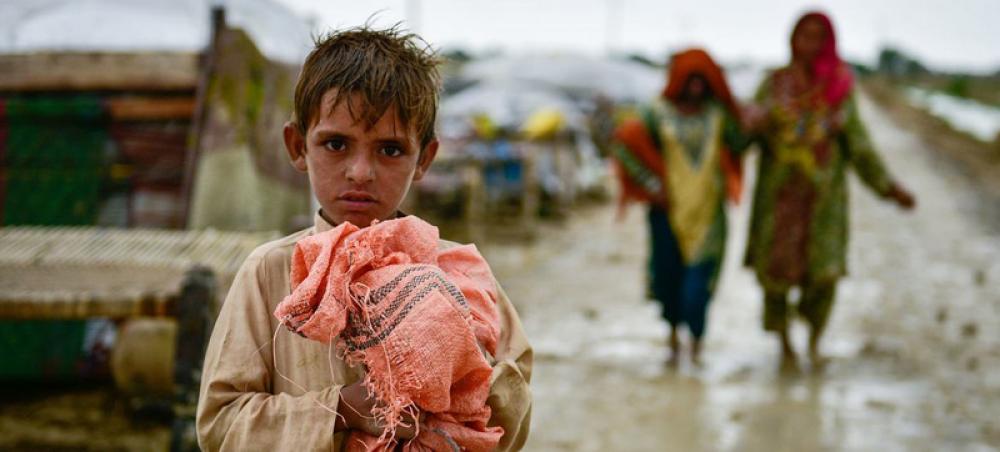Just Earth News | @justearthnews | 30 Aug 2022

© UNICEF/A. Sami Malik
New York: A $160 million emergency plan to help Pakistan deal with devastating flooding has been launched by the United Nations, aiming to reach “5.2 million of the most vulnerable people in the country”.
An estimated 33 million people have been affected by the “worst flooding in decades "and more than 1,000 people, mostly children”, have died since mid-June when heavy rains began pounding the country, Jens Laerke, spokesperson for the UN humanitarian coordination office, OCHA, said on Tuesday.
"Pakistan is awash in suffering," UN Secretary-General António Guterres said in a video message to launch the six-month appeal in Islamabad and Geneva.
'Unprecedented climate catastrophe'
In a note to correspondents issued on Tuesday afternoon in New York, the Spokesperson's Office said that given the "tragic situation facing millions" across the country, the UN chief would travel to Pakistan on a solidarity visit, arriving on Friday in Islamabad.
"He will then travel to the areas most impacted by this unprecedented climate catastrophe."
In his video message earlier, Guterres said "the Pakistani people are facing a monsoon on steroids - the relentless impact of epochal levels of rain and flooding."
According to Laerke, 500,000 people displaced by the floods “are sheltering in relief camps … nearly one million homes have been damaged and over 700,000 livestock have been lost”.
The humanitarian situation has also been compounded by severe impacts to infrastructure. Damage to nearly 3,500 km of roads and 150 bridges has impeded the ability of people to flee to safer areas, he said, and compromised the delivery of aid to the millions in need.
Three key objectives
According to the OCHA spokesperson the plan focuses on three key objectives: “first, delivering lifesaving and livelihood assistance, such as health services, food, clean water and shelter.
“Secondly, to prevent large outbreaks of communicable diseases such as cholera and assist small children and their mothers with nutrition.”
The third aim is to ensure that “people can access assistance and protection in a way that is both safe and dignified, including family tracing”.
Matthew Saltmarsh, UN refugee agency (UNHCR) spokesperson, told reporters in Geneva that to date, the agency’s response has focused on “emergency provision going into the affected regions and providing emergency relief items. These include primarily shelter items, but also, “cooking stoves, blankets, solar lamps.”
“So far, we've delivered $1.5 million worth of aid, but much, much more will be needed in the coming weeks and also over the medium term, including development assistance,” Saltmarsh said.
Devastating impact
Pakistan has endured severe monsoon weather since June, which saw rainfall levels 67 per cent above normal in that month alone, OCHA said in a statement. As of 27 August, rainfall in the country has been equivalent to 2.9 times the national 30-year average.
To date, 72 districts across Pakistan have been declared “calamity-hit” by the government. Amid ongoing rains, the number of calamity-declared districts is expected to increase.
“When we hear flooding, we very often just think about people drowning, but it's so much more to it,” said Christian Lindmeier, World Health Organization (WHO) spokesperson. “You have crush injuries from the debris floating in the water. You have electrical shocks from wires… you have the lack of drinking water,” which is “not only a problem for the immediate situation, but for the medium situation as well”.
The WHO spokesperson also warned that “at least 888 health facilities have been severely affected…180 of which are completely damaged at this point”.
The ‘pendulum has swung’
According to the Global Climate Risk Index 2021 and Climate Watch, Pakistan is among the 10 countries most affected by extreme weather events, despite its very low carbon footprint.
According to Clare Nullis, World Meteorological Organization (WMO) spokesperson, the deadly flooding is “the footprint of climate change where it is becoming more extreme”. In March and April, Pakistan “was in the grips of this devastating heat wave and drought” and now “the pendulum has swung”, she warned.